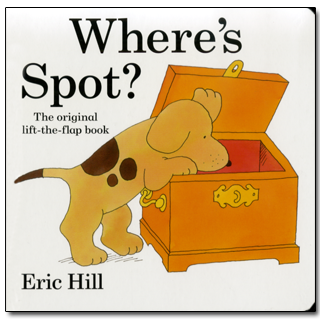
A FEW OTHER EVENTS FOR
SEPTEMBER 16:
- Happy birthday Joanne Ryder (Bear of My Heart; Little Panda: The World Welcomes Hua Mei at the San Diego Zoo).
- In 1620 the good ship Mayflower set sail from Plymouth, England to America. Hence, it is Mayflower Day. Read Mayflower 1620: A New Look at a Pilgrim Voyage by the Plimoth Plantation, with Peter Arenstam, John Kemp, and Catherine O’Neill Grace.
- In 1630 the Village of Shawmut changed its name to Boston. Read A Million Miles From Boston by Karen Day.
- It’s Stepfamily Day. Read Out of Order by Betty Hicks and Wait Till Helen Comes by Mary Downing Hahn.
September has been designated World Animal Remembrance Month—and today I’m going to talk about one of the dogs most loved by the preschool set, Eric Hill’s Spot.
It is hard to believe that this pooch has only been around for thirty-one years. The ongoing saga of Spot began not with Spot himself, but his mother Sally. In Where’s Spot? published in 1980, Sally goes searching for her son. As this yellow dog, with brown spots and a distinctive brown-tipped tail, looks around the house, she opens a door to find . . . a bear. And then young readers lift several flaps in the book to see what Sally sees: a hippo in the piano, a monkey in the closet, and a turtle under the rug. Only in the end does Sally find the adorable Spot—nicely nestled in a basket.
Like many classics the book came about because of a child. Although never formally trained in art school, at fifteen Eric Hill studied informally with a cartoonist. While Hill was working as a freelance artist and designer, he noticed that his two-year-old son Christopher loved lifting flaps on the advertising pieces that Hill was creating. Hill had always been intrigued by the question of what his beloved dog actually did when the family left the house. He imagined that the dog had a secret life, never seen by owners. So in Where’s Spot? he explored the idea of dogs at home with no human intervention and an imaginative lift-the-flap game. The book became such an immediate success that Hill was able to create children’s books full time.
As a book for very young children, Where’s Spot? does so many things right. It helps with place identification and animal identification. It provides a repetitive story pattern and a guessing game. And using very few words, the book presents a small story arc—a beloved son is lost and finally found in a story under a hundred words. The art itself—clear and clean, with strong black outline and bright colors—has been showcased on bright thick stock, making it durable for the youngest reader. All the paper engineering details have been worked out brilliantly. Even on the first page, the flap can be lifted to put in the child’s name in “This book belongs to.” Perfect for shower gifts or the first book on a child’s bookshelf, the Spot series has been translated into sixty languages and sold over fifty million copies worldwide.
If you are buying books for a preliterate child, pick up Where’s Spot? It—almost—makes me long for another puppy!
Here’s a page from Where’s Spot?:
Originally posted September 16, 2011. Updated for .














Well now, I’m out looking for Spot myself. The book that is.
Can’t wait.
All three of my children loved this series when they were small. They enjoyed lifting the flaps to see what was underneath, and trying to guess what would happen next.
If there’s a way to tell babies that reading is fun, it’s to let their little hands be involved. Where’s Spot? is a perfect baby book.
My son loved this book, and would say “‘Pa? ‘Pa?” for Spot as he opened each flap. Then once when we read the book Dinosaur’s Binkit (another good lift-the-flap book for toddlers), he opened the dinosaur’s mouth and said “‘Pa?” and giggled. I think it was his first joke. (Where’s Spot? is he . . . in the dinosaur’s mouth?)
I’m not sure that I’ve ever seen a copy of this book that wasn’t bedraggled – but that’s a good thing! It’s a testament to the fact that children really do love the suspense of the flap, and love it enough to go back and manhandle (babyhandle?) it many times over.
I’ve read it now. It’s really well done. The color and images are prefect. The word flow feels effortless. Simple and fun.
Excellent little book.
When my siblings came along in 1982, this was one of the first books I remember reading to them. I was 10. This book brings back such memories of the house we lived in at the time. Wow, hadn’t thought of Where’s Spot in a while.
The sequels weren’t as good as the original. But wow, we all loved that book.
Thanks, Anita.
Children love returning to this old favourite. It intrigues me the way the youngest children grasp the writing style which I describe as an off stage narrator. I think the other key to success here is the way adult readers quite naturally adopt different voices for each character.